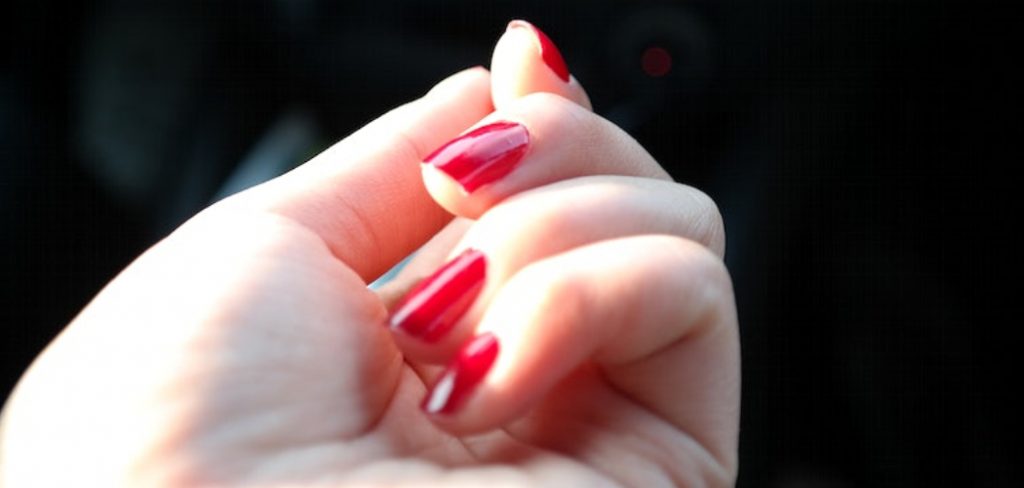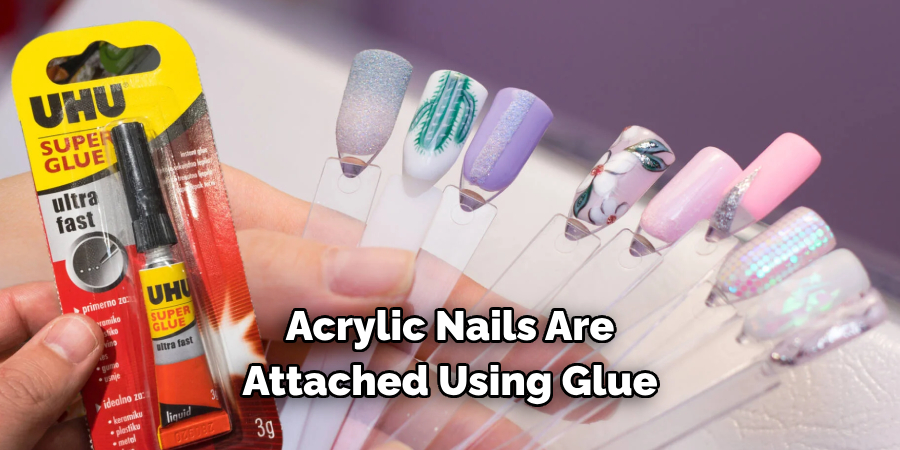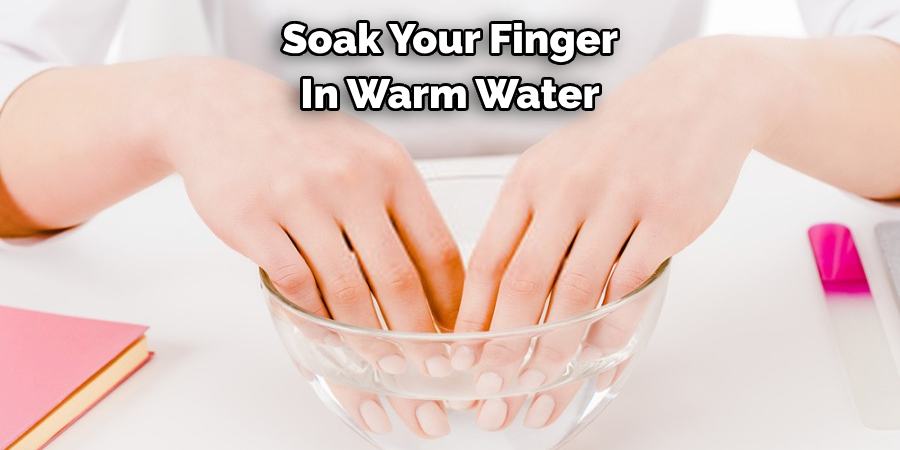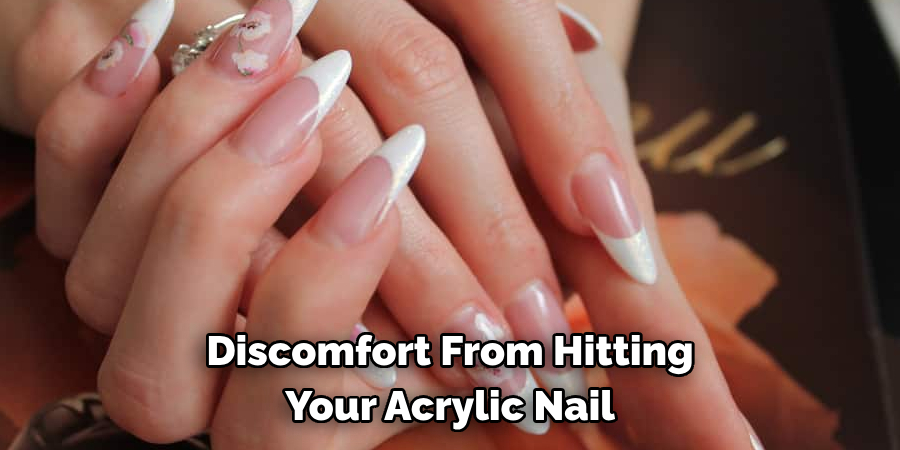Are you trying to figure out how to stop acrylic nail from hurting after hitting it? Acrylic nails can be tricky and if not taken care of properly, they can cause quite a lot of discomfort. Unfortunately, accidents happen and it’s likely that at some point your acrylic nail will get hit hard enough for you to experience a good amount of pain.

Whether the pain occurred when something was dropped on your hand or when banging your nail against something else, the result is still the same—acrylic nail hurt! But don’t despair; this article will provide tips on how to prevent further pain and heal damage quickly so you won’t have to suffer any longer.
Why is It Important to Stop Acrylic Nail From Hurting After Hitting It?
1 . To Avoid Infection
When acrylic nails are hit hard, they can lift up from the natural nail bed. This creates an opening for bacteria and germs to enter, potentially leading to infection. It’s important to take immediate action in order to prevent any further damage or complications.
2 . To Relieve Pain
Acrylic nails are attached using glue which can be quite strong. When hit, the nail can pull on the natural nail bed and cause pain and discomfort. By stopping your acrylic nail from hurting after hitting it, you can alleviate any pain or tenderness that you may be experiencing.
3 . To Maintain Aesthetics
Let’s face it, no one wants to walk around with a damaged acrylic nail. It can be embarrassing and ruin the overall appearance of your manicure. By taking care of the issue quickly, you can maintain the aesthetic appeal of your acrylic nails.

12 Tips on How to Stop Acrylic Nail From Hurting After Hitting It
1 . Apply Ice Pack
As soon as possible after hitting your acrylic nail, apply an ice pack to reduce any pain or swelling. Wrap the ice pack in a towel and hold it on your finger for 10-15 minutes. This will also help to numb the area and provide relief.
2. Soak in Warm Water
After the initial swelling has gone down, soak your finger in warm water for a few minutes. This will help to soften the acrylic and make it easier to remove if necessary. This will also help to promote blood flow and aid in the healing process.

3. Remove Any Loose Acrylic
If your acrylic nail is loose or hanging off, gently remove it using a cuticle pusher or tweezers. Be careful not to apply too much pressure or pull on the nail, as this can cause further pain and damage.
4. Trim Your Nails
If you have any jagged edges or sharp corners on your natural nail, carefully trim them using a nail clipper. This will help to prevent further injury and discomfort. Also, keep your nails trimmed to avoid accidentally hitting them again.
5. Apply Antibacterial Ointment
To prevent any infection, apply a small amount of antibacterial ointment to the affected area. This will also help to soothe and protect the skin around your nail. This will be especially beneficial if you have any cuts or scrapes from the impact.
6. Use Pain Relief Cream
If the pain persists, you can also apply a pain relief cream to the area. This will help to alleviate any discomfort and promote healing. Just make sure to follow the instructions on the specific product for safe and effective use.
7. Take Over-the-Counter Pain Medication
If the pain is severe, you can also take over-the-counter pain medication such as ibuprofen or acetaminophen. This will help to reduce any inflammation and provide temporary relief. Also, consult with your doctor or pharmacist before taking any medication.

8. Keep Your Finger Elevated
To reduce swelling and pain, keep your finger elevated above your heart as much as possible. This will help to improve blood flow and reduce pressure on the affected area. You can prop it up using pillows or simply rest your hand on a table.
9. Avoid Using Your Affected Finger
To allow your acrylic nail and natural nail to heal properly, try to avoid using your affected finger as much as possible. This will also prevent any further pain or damage. Use your other fingers for daily activities and tasks.
10. Apply Bandage if Necessary
If you have any cuts or scrapes from the impact, apply a bandage to protect the area and promote healing. Make sure to change the bandage regularly to prevent any infection. You can also use a finger sleeve or glove for added protection.
11. Keep Your Nails Moisturized
To keep your nails healthy and strong, make sure to moisturize them regularly using cuticle oil or hand cream. This will help to prevent dryness and brittleness, which can make your nails more susceptible to damage.
12. See a Doctor if Pain Persists
If the pain and discomfort from hitting your acrylic nail continue for more than a few days, it is best to seek medical attention. You may have sustained further injury or developed an infection that requires treatment. Do not hesitate to consult with a doctor for proper care.

Frequently Asked Questions
What Precautions Can I Take to Avoid Acrylic Nail Pain?
If you love wearing acrylic nails, it’s essential to take extra precautions to avoid pain and discomfort. Here are some tips to keep in mind: Choose a reputable salon with experienced nail technicians who know how to apply acrylic nails correctly. Make sure your nail technician sanitizes their tools before use, as this can prevent infections and other nail issues. It’s also essential to communicate with your nail technician about any allergies or sensitivities you may have to certain products used during the application process.
Why Does My Acrylic Nail Hurt After Hitting It?
If you accidentally hit your acrylic nail, it can hurt because of the pressure applied to the sensitive nail bed beneath. The pain can range from mild discomfort to more severe throbbing and aching. The pain may also be caused by the acrylic nail lifting or shifting, causing pressure on the natural nail underneath. Additionally, if your acrylic nails are not applied correctly or are too thick, they can put extra strain on your natural nails, resulting in pain.
How Can I Stop My Acrylic Nail From Hurting After Hitting It?
If you experience pain after hitting your acrylic nail, there are a few steps you can take to alleviate the discomfort. First, try using an ice pack or cold compress on the affected area to reduce swelling and numb any pain. You can also take an over-the-counter pain reliever if necessary. If the pain persists or becomes severe, it’s best to visit your nail technician or doctor for further assistance.
They can assess the damage and provide appropriate treatment, such as trimming the acrylic nail or providing medication for infection. In the future, be mindful of your acrylic nails and take care to avoid hitting them.
Can I Prevent Acrylic Nail Pain Altogether?
While some discomfort may be unavoidable, there are steps you can take to minimize the likelihood of acrylic nail pain. First, make sure your acrylic nails are applied correctly by a skilled technician. Also, avoid hitting or putting pressure on your nails as much as possible, and refrain from picking at them. Proper maintenance and care, such as regular fills and keeping your nails moisturized, can also help prevent pain.
If you have a low pain tolerance or sensitive nail beds, you may want to consider alternative nail options such as gel or dip powder. Remember to always prioritize the health and well-being of your natural nails over aesthetics. So, if necessary, take breaks from wearing acrylic nails to give them time to rest and heal.
How Much Pain is Normal with Acrylic Nails?
Mild discomfort, especially during the first few days of wearing acrylic nails, can be normal. However, if the pain is severe, persistent, or accompanied by other symptoms such as redness, swelling, or discharge from the nail bed, it may indicate a more serious issue. In this case, it’s best to seek medical attention to avoid further complications. Remember, it’s essential to listen to your body and prioritize its health over beauty trends. With proper care and maintenance, you can enjoy wearing acrylic nails without experiencing excessive pain or discomfort.
Conclusion
Hitting your acrylic nail can be painful and uncomfortable, but by following these tips, you can alleviate the pain and promote healing. Remember to be gentle with your affected finger and seek medical attention if necessary. Taking good care of your nails is also important in preventing future incidents.
Now you know how to stop acrylic nail from hurting after hitting it, so you can continue to enjoy your beautiful manicure without any discomfort. So remember, stay cautious and be mindful of your nails to prevent any accidents in the future. And if you do happen to hit your acrylic nail again, just refer back to these tips for some quick relief!
About the Author
Jane Hubbard is a passionate beauty expert with a wealth of experience in makeup, hair, and overall beauty techniques. After years of working as a hairdresser specialist, she followed her entrepreneurial spirit and started her own consultancy business.
Jane has always been driven by her desire to help others feel confident in their own skin, and she does this by sharing her knowledge, experiences, and practical beauty tips. Through her consultancy, she empowers individuals to embrace their unique beauty, offering tailored guidance that boosts both self-esteem and personal style.
Professional Focus
- Specializes in makeup, hairstyling, and beauty consulting.
- Provides personalized beauty advice, tips, and techniques to help individuals feel confident in their appearance.
- Dedicated to staying up-to-date with the latest industry trends and developments.
- Passionate about creating a comfortable and empowering experience for every client.
Education History
- University of Craft and Design – Bachelor of Fine Arts (BFA) in Woodworking and Furniture Design
- Woodworking Apprenticeships – Extensive hands-on training with skilled craftsmen to refine carpentry and furniture making techniques
- Online Courses & Masterclasses – Continued education in advanced woodworking techniques, design principles, and specialized tools
Expertise:
- Makeup artistry, hairstyling, and beauty consulting.
- Personalized beauty techniques to enhance confidence and self-expression.
- Educating clients on how to maintain their beauty routines at home.
